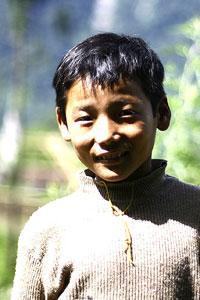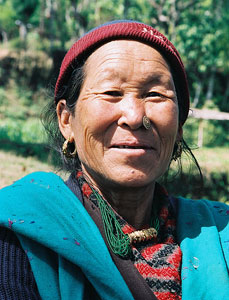|
|
|
Sikkim People |
|
|
|
About People of Sikkim
The culture, religion, customs and traditions of different
communities of people living in Sikkim constitute a
homogeneous blend. These three communities are the Lepchas,
Bhutias and Nepalis. In urban areas many people have settled
which are engaged in business and government services. Due to
the development activities in the state like the construction
of roads, bridges and buildings various labourers migrated
from the plains and Nepal. |
|
|
|
The
Lepchas
The Lepchas were the original inhabitants of Sikkim
before the Bhutias and Nepalis. The word 'Leppcha' means
the ravine folk. These people mostly live on agriculture
of paddy, cardamom and oranges. The Lepchas are
predominantly the Buddhists but many of them are also
Christians. But before adopting Buddhism or Christianity
as their religion, the earliest Lepcha settlers believe
in the bone faith or mune faith based on the spirits,
good and bad. They worshipped spirits of mountains,
rivers and forests which was very natural for a tribe
during those days. Today, the Lepchas resides in the
central part of the Sikkim. The Lepcha folklore is rich
with stories. The villages of the Lepchas are very
small. A Lepcha hut is usually made of bamboo and is
raised about five feet above the ground on stilts. There
are just a couple of rooms with only small minimum
essential requirements of life. The male Lepcha wears a
dress called a "pagi" made of cotton, which is stripped.
The female Lepcha wears a two piece dress. The Lepchas
speak the Lepcha language. This language is not very
well developed but is very rich in vocabulary and
related to the flora and fauna of Sikkim. Hunting of the
wild animals and fishing are the main |
 |
|
|
occupation of
the Lepcha people. The Lepcha people are also very good at
archery. The polyandry marriages are permitted amongst the
Lepchas, but now this is very rare. Nowadays, the government
also feels protective towards the Lepchas. |
|
|
|
The
Bhutias
The Bhutias originally belongs to the Tibet. These
people migrated to Sikkim after the 15th century and
settled in North Sikkim. These people are known as the
Lachenpas and Lachungpas in the North Sikkim. The
Bhutias speak the Sikkimese language, a dialect of the
Tibetan language. Bhutias constitute about ten percent
of the total population of Sikkim. The villages of
Bhutia are very large as compared to those of Lepchas. A
Bhutia house called "Khin" is usually in the shape of a
rectangle. The male Bhutia wears a traditional dress
known as the "Bakhu" which is a loose cloak type garment
with full sleeves. The ladies wears a silken "Honju"
that is a full sleeve blouse and |
 |
|
|
a loose gown
type garment. The ladies are very fond of heavy jewellery made
of pure gold. The marriage in a Bhutia family is also arranged
through negotiations. Before the marriage, the boy's uncle
goes to the girl's house with gifts to ask for the hand in
marriage for his nephew.
|
|
|
The Nepalis
The Nepalis are third type of people that live in Sikkim
after the Bhutias. They migrated in large numbers in
Sikkim after the Lepchas and Bhutias. Today, the Nepalis
constitute more than 80 % of the total population of
Sikkim. The Nepalis introduced the terraced system of
cultivation and the cardomom was an important cash crop
introduced by them. Some of the Nepalis are the Hindus
except the Sherpas and Tamangs who are Buddhists. The
business class people of Nepalis are known as Newars.
The Nepalis speak the Nepali language, which is
understood by the people all over the state. This
language is similar to Hindi and uses the Devanagri
script. The male Nepali wears a traditional dress that
consists of long double breast garment flowing below the
waist and a trouser known as "Daura Suruwal". The female
wears a dress that consist of a double breasted garment,
which is known as "Chow Bandi Choli". They also wear a
shawl known as "Majetro". |
 |
|
|
|
|
 |
|
Car Rental |
|